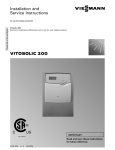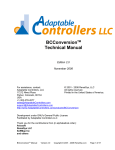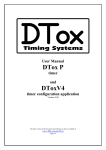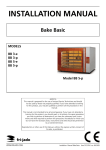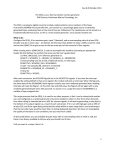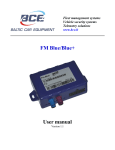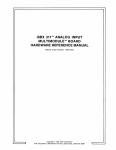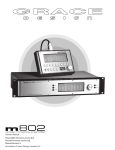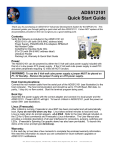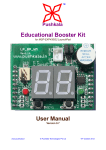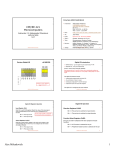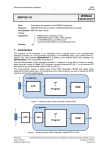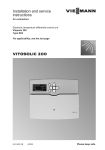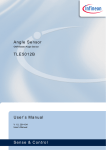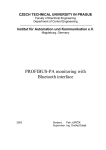Download \ swk4 "swiss knife" 4bit I/O \ using 4e4th Release0.34 on TI
Transcript
\ \ \ \ swk4 "swiss knife" 4bit I/O using 4e4th Release0.34 on TI MSP430G2553 MCU LaunchPad started: mka, 2014_10_26 Idea: Juergen Pintaske \ \ \ \ \ \ \ \ \ \ \ History: added: DEMOLOOP to select examples with S2 and S1 switches. cleaning up examples, added EX12 (3.11.2014) added: 2 servo examples (02.11.2014) added: 4 servo pulses to OUT (30.10.2014 22:47) renamed demos to EXx (29.10.2014 21:19) added: some demos Px (29.10.2014 13:05) added: ADC (29.10.2014 00:02) first test today (26.10.2014 23:49) Compiles in target without errors. blocks with mk0 mark = tested ok on first glance ... ... functioning, stack ok. MYBONNIE is playing, no stack error - ok PWM running, SWEEP is ok. I/O and nibbels working on variables. mem u. 6703 (plenty flash left) \ \ \ \ \ Issues: \ Glitches while setting upper nibble of P2 - fixed OUT! \ port name P2 is in conflict with modul name P2 - renamed. \ +++++++++++++++++++++++++++++++++++++++++++++++++++++++++++++ \ Start of Program SWK4 programmed in Forth \ \ \ \ \ \ This program gives some routines planned to help Learning \ Programming. And we use them here as an example of how to program the MSP430 Controller. Add the 5 resistor LED combinations and the 3 switches to e th430 board and run routines completely in the MSP430, using Forth wich is on this chip as well. \ Defining the I/O for this application \ Device Pinout: MSP430G2553 20-Pin PDIP \ (TOP VIEW) \ \ \ \ \ \ \ \ \ \ VCC-----------------[01 (LED1 LP) AD0 P1.0--[02 RXD-----------P1.1--[03 TXD-----------P1.2--[04 (S2 LP)----S2 P1.3--[05 ..........AD4 P1.4--[06 _-_-_-_-_-FRQ P1.5--[07 ----------IN0 P2.0--[08 ----------IN1 P2.1--[09 ----------IN2 P2.2--[10 \ \ \ \ \ \ \ \ \ P1.0 P1.1 P1.2 P1.3 20]-------------VSS 19]--P2.6 OUT2 18]--P2.7 OUT3 17]--test 16]--RST S1-LP 15]--P1.7 S1 [SPI] 14]--P1.6 PWM LED2-LP [SPI] TA0.1 13]--P2.5 OUT1 12]--P2.4 OUT0 11]--P2.3 IN3 used as Input, later on as Analog Input 1 RX and TX are used as the serial interface to the PC used as S2 as on the TI Launchpad, internal resistor enabled P1.4 used as Input, later on as Analog Input 2 P1.5 used as Output, later on to output a frequency with defined length P1.6 Outout, later on as Pulse Width Modulation output \ – quasi D/A Output \ P1.7 Input S1, internal resistor enabled \ \ \ \ \ \ All P2.x Inputs have internal resistor enabled, so open input means HIGH P2.0 Input 0 P2.1 Input 1 P2.2 Input 2 P2.3 Input 3 \ \ \ \ P2.4 P2.5 P2.6 P2.7 \ \ \ \ The MSP 430 will be rather fully used. So to save Program Space, the 4 Bit Nibbles are packaged into 4x4 nibbles to be one Variable (16Bit cell). This will save on RAM used. Output Output Output Output 0 1 2 3 \ Some scrach variables mk0 \ IN 4 bit input, when used reflects status of 4 Input lines \ F 4 bit value for tones \ A 4 bit A register \ B 4 bit B register variable IFAB \ define a variable \ W 4 bit W \ X 4 bit A \ Y 4 bit Y \ Z 4 bit Z variable WXYZ variable variable variable variable \ A1 4 bit analog in channel 1 \ A2 4 bit analog in channel 2 \ P 4 bit pulse width modulated output \ O 4 bit output register variable 12PO : INITSV \ -- \ init scrach variables 0 IFAB ! 0 WXYZ ! 0 12PO ! ; initsv \ define a Word to show a cell at address unsigned : ? ( adr -- ) @ u. ; \ juggling nibbles mk0 HEX : 0! \ n adr -- \ store nibble 0 to variable at >r r@ @ FFF0 and swap F and + r> ! ; : 1! \ n adr -- \ store nibble 1 to variable at >r r@ @ FF0F and swap F and 4 lshift + r> ! ; : 2! \ n adr -- \ store nibble 2 to variable at >r r@ @ F0FF and swap F and 8 lshift + r> ! ; : 3! \ n adr -- \ store nibble 3 to variable at >r r@ @ 0FFF and swap F and C lshift + r> ! ; : 0@ \ adr @ 000F and : 1@ \ adr @ 00F0 and mk0 address address address address n \ fetch nibble 0 of variable at address ; n \ fetch nibble 1 of variable at address 0004 rshift ; : 2@ \ adr @ 0F00 and : 3@ \ adr @ F000 and \ \ \ \ \ \ \ \ n \ fetch nibble 2 of variable at address 0008 rshift ; n \ fetch nibble 3 of variable at address 000C rshift ; As a first step we have to define the relevant IO Bits as Input ( with enabling internal pull-up resistor) or as output. Here you can find the relevant memory mapped addresses to set functionality, read Input Data, write Output Data Some of the functions used are rather complex, so in the beginning we will test as Input and Output only, see separate Forth Code \ In 4e4th, P1 and P2 are predefined 2constants. HEX : INITIO \ -- \ I/O initialisation of JPS4 ports mk0 \ mask adr op \ 76543210 [ bin ] 10011001 [ hex ] 0022 ( P1DIR ) cclr \ P1 INs [ bin ] 01100110 [ hex ] 0022 ( P1DIR ) cset \ P1 OUTs [ bin ] 10001000 [ hex ] 0024 ( P1IES ) cset \ falling edge detect [ bin ] 00100000 [ hex ] 0026 ( P1SEL ) cset \ P1.5 sec func TA0.0 (FRQ) [ bin ] 10001000 [ hex ] 0027 ( P1REN ) cset \ pullup selected [ bin ] 10000000 [ hex ] P1 cset \ P1.7 pullup enabled [ bin ] 00001111 [ hex ] 002A ( P2DIR ) cclr \ P2 INs [ bin ] 11110000 [ hex ] 002A ( P2DIR ) cset \ P2 OUTs [ bin ] 00001111 [ hex ] 002F ( P2REN ) cset \ P2 pullups selected [ bin ] 00001111 [ hex ] P2 cset \ P2 pullups enabled [ bin ] 11000000 [ hex ] 002E ( P2SEL ) cclr \ clear these bits to I/O ; INITIO \ Basic I/O mk0 HEX : OUT! \ n -- \ write OUT to P2 upper nibble (4 LEDS) 04 lshift \ move to n upper nibble 0F or \ keep input pullups set! p2 c! ; \ write port : OUT> \ -\ copy O to OUT! 12PO 0@ out! ; : OUT \ n -\ save n to O and do OUT! 12PO 0! out> ; : IN@ \ -- n \ read digital input pins (nibble ) P2 1- c@ 000F and ; \ helper to output a nibble to terminal HEX : 4# \ n -\ display 4 digits unsigned with leading zeros <# zero # # # # #> TYPE SPACE ; : 2# \ n -\ display 2 digits unsigned with leading zeros <# zero # # #> TYPE SPACE ; \ test falling edge at switch S1 and S2 mk0 023 constant P1IFG : S1? 080 P1IFG cget ; \ -- f \ set on edge event : S2? 008 P1IFG cget ; \ -- f \ set on edge event : S1- 080 P1IFG cclr ; \ -\ reset edge event flag : S2- \ \ \ \ \ \ 008 P1IFG cclr ; \ -- \ reset edge event flag Delays mk0 1MS is prefefined in 4e4th. Its an empty loop, predefined for MCU running with 8Mhz DCO = default. Use Forth word MS to make any ms delay. Example: decimal 10 ms \ delay of 10 miliseconds. DECIMAL : 1SEC \ -- \ delay of one second 1000 ms ; : SECS \ n -\ delay of n seconds 0 DO 1sec LOOP ; mk0 \ -----------------------------------------------------------\ Utilities for this MCU \ -----------------------------------------------------------\ -----------------------------------------------------------\ Tones \ Output is for MSP430G2553, 8Mhz DCO and SMCLK /2 HEX \ Output square wave at P1.5 using timer TA0.0 \ \ \ \ \ \ mk0 Use P1.5 as timer TA0.0 ouput. This is done by setting P1.5 to its second function. Then set and start Timer. Note: In second function, pin is no longer a general purpose I/O pin. It is switched to another I/O mode called 'second function' of the pin. : P15SEC \ set P1.5 to its second function 020 dup p1 1+ cset 026 cset ; : P15IO \ set back P1.5 to its GPIO 020 026 cclr 020 041 cclr ; : TON- zero 0160 ! p15io ; : TON+ \ n -p15sec 0080 0162 ! ( n ) 0172 ! 0254 0160 ! ; \ \ \ \ \ \ stop timer start timer-A with interval n init pin CCTL0 set timer output mode CCR0 set interval CTL start timer clock, mode and divider \ midi tones B3 to B5, 2 octaves; pitch list. DECIMAL IHERE 0000 i, \ no tone 7962 i, \ B3 7515 i, \ C4 6695 i, \ D4 5965 i, \ E4 5630 i, \ F4 5016 i, \ G4 4469 i, \ A4 3981 i, \ B4 mk0 3758 i, \ C5 3348 i, \ D5 2983 i, \ E5 2815 i, \ F5 2508 i, \ G5 2235 i, \ A5 1991 i, \ B5 constant TONELIST : T@ \ i -- n \ get pitch using index i cells tonelist + @ ; DECIMAL : NOTE \ i -\ play t@ ton+ 500 ms ; : LNOTE \ i -\ play note 500 ms ; : PAUSE \ n -\ play ton- ms ; \ ( use n = note i note i longer pause of duration n 50,100,200) \ see example melodie EX14 \ -----------------------------------------------------------\ PWM of 16KHz mk0 \ for 8MHZ DCO using timer TA0 HEX : P16IO \ -\ set P1.6 to GPIO 0040 0022 cset \ P1DIR P1.6 OUT 0040 0026 cclr \ P1SEL P1.6 GPIO ; : P16SEC \ -\ set P1.6 to second function 0040 0022 cset \ P1DIR P1.6 OUT 0040 0026 cset \ P1SEL P1.6 select second function ; : PWMzero 160 ! \ TA0CTL stop timer p16io 0040 0021 cclr ; \ set p1.6 I/O and clear p1.6 : PWM+ \ n -01F4 0172 ! 00E0 0164 ! 0174 ! 0210 0160 ! ; \ \ \ \ \ init and start PWM at P1.6 TA0CCR0 set period 16KHz at 8MHZ DCO TA0CCTL1 set output mode TA0CCR1 set pulsewidth TA0CTL set timer mode and run : PWM \ n -\ set PWM at P1.6 ton- 000F and dup 0= IF drop pwmELSE 001F * pwm+ p16sec THEN ; n = 0...F \ -----------------------------------------------------------\ ADC HEX \ You may name addresses and bits. \ address name \ function \ 01B0 constant ADC10CTL0 \ ADC10 control register 0 \ 01B2 constant ADC10CTL1 \ ADC10 control register 1 \ 004A constant ADC10AE0 \ 01B4 constant ADC10MEM \ ADC10 input enable register 0 \ ADC10 Memory, conversion result \ \ \ \ \ \ some 0002 4000 10 0001 0004 \ \ \ \ \ \ \ \ \ \ \ \ \ option bits are: 2000 constant SREF_1 \ set VR+ = VREF+ and VR- = AVSS 1000 constant ADC10SHT_2 \ 16 x ADC10CLKs 0040 constant REF2_5V \ ADC10 Ref 0:1.5V / 1:2.5V 0020 constant REFON \ ADC10 Reference on 0010 constant ADC10ON \ ADC10 On/Enable ---3070 <-- sum of option bits named bits constant ENC constant INCH_4 constant BIT4 constant ADC10SC constant ADC10IFG : ADCOFF \ -zero 01B0 ! ; ADC10 Enable Conversion bit Selects Channel 4 for P1.4 Analog Input Enable start conversion bit ADC10 Interrupt Flag \ stop ADC10 ... \ ... can be modified only when ENC = 0 : ADCON \ -- \ start ADC10 0002 01B0 set ; \ Set ENC : ADC@ \ -- x \ get ADC value 03 01B0 SET \ start conversion (ENC+ADC10SC bits) BEGIN 04 01B0 cget UNTIL \ test BIT2 (ADC10IFG) 01B4 @ ; \ get result : ADC0 \ -adcoff 3070 01B0 ! 0100 01B2 ! 01 004A cset ; \ select and init ADC channel 0 : ADC4 \ -adcoff 3070 01B0 ! 4000 01B2 ! 10 004A cset ; \ select and init ADC channel 4 \ set options (see MCU user manual) \ select input channel (A0 at P1.0) \ set pin, analog input enable \ set options (see MCU user manual) \ select input channel (A4 at P1.4) \ set pin, analog input enable \ Example: \ adc4 adcon adc@ . \ print single conversion \ -----------------------------------------------------------\ 4 servos connected to OUT \ \ \ \ \ Use extern DC power supply for servos. Connect servo-GND to MCU-GND. Connect servo control lines to OUTx. Control line needs one 1..2ms puls, 20ms pause, ~$40x, for one position HEX variable variable variable variable x0 x1 x2 x3 : LDX \ x0 x1 x2 x3 -- \ load variables X0 .. X3 x3 ! x2 ! x1 ! x0 ! ; : INITX \ -- \ load X0 .. X3 wit &500 500 dup dup dup ldx ; initx : x? \ -- \ print all X x0 ? x1 ? x2 ? x3 ? ; : DEX \ x -- \ waste time x 0 DO LOOP ; : PULS \ x n -- \ send puls x to bit n of P2; n=80,40,20,10 >r r@ p2 cset dex r> p2 cclr 4 ms ; : SERVE x0 @ 10 x1 @ 20 x2 @ 40 x3 @ 80 \ -- \ send one puls to all servos puls puls puls puls ; : SERVOS \ -- \ position all servos initio 30 0 DO serve LOOP ; DECIMAL \ set x to &480 : SER0 \ x -- \ x0 ! servos ; : SER1 \ x -- \ x1 ! servos ; : SER2 \ x -- \ x2 ! servos ; : SER3 \ x -- \ x3 ! servos ; ... &1700 (Range is ~1200 steps) reposition servo0 reposition servo1 reposition servo2 reposition servo3 \ adjust x-min and x-max to match your servo. \ test for oscilloscope : SERTEST \ -- \ position all servos, permanent initio BEGIN serve key? UNTIl ; \ -----------------------------------------------------------\ Initialisation DECIMAL : INIT \ -- \ set pin I/O and variables. initio initsv initx ; \ -----------------------------------------------------------\ Example Programms \ -----------------------------------------------------------\ -----------------------------------------------------------\ Example 0 - leave demo loop, run forth. : EX0 cr .ver cr ." forth - command me." abort ; \ -----------------------------------------------------------\ Example 1 - display IN (1) HEX : EX1 \ -- \ IN to OUT mk0 initio BEGIN in@ out \ get IN and store it to OUT key? UNTIL key drop ; \ leave loop, clean up \ -----------------------------------------------------------\ Example 2 - display IN (2) HEX : EX2 \ -- \ IN to PWM and OUT mk0 initio BEGIN in@ \ get IN dup out \ store to OUT PWM 1sec \ do PWM for a second key? UNTIL \ leave loop, clean up key drop pwm- ; \ -----------------------------------------------------------\ Example 3 - falling edge detector (1) HEX : EX3 \ -- \ faling edge detector S2 to OUT0 mk0 initio s2\ init system and reset edge detection BEGIN s2? IF 1 out \ set on edge detect 1sec s2- zero out \ wait, then reset THEN key? UNTIL \ leave loop, clean up key drop ; \ -----------------------------------------------------------\ Example 4 - falling edge detector (2) HEX : EX4 \ -- \ falling edge detector S2 to note mk0 initio s2- \ init system and reset edge detection 01 note \ start low note BEGIN s2? IF 1 out \ set on edge detect 0F note \ do high note 1sec s2- zero out \ wait, then reset out ... 01 note \ and low note THEN key? UNTIL \ leave loop, clean up key drop ton- ; \ -----------------------------------------------------------\ Example 5 - toggle OUT bits HEX : tout \ c -- c \ dup [char] 1 = IF 01 12po ctoggle out> exit THEN dup [char] 2 = IF 02 12po ctoggle out> exit THEN dup [char] 3 = IF 04 12po ctoggle out> exit THEN dup [char] 4 = IF 08 12po ctoggle out> exit THEN dup [char] 0 = IF zero out exit THEN dup [char] f = IF 0f out exit THEN ; : EX5 \ -- \ press 1 2 3 4 to toggel OUT bits, \ 0 to clear all, F to set all. initio zero out BEGIN key tout 1B ( esc ) = UNTIL ; \ exit on esc-character \ -----------------------------------------------------------\ Example 6 - dance of 4 servos DECIMAL 0480 constant SL 1700 constant SR 1000 constant SM IHERE SL i, SL SR i, SR SM i, SM SL i, SL SM i, SM SR i, SR CONSTANT i, i, i, i, i, i, M0 \ SL SM SR SM SL SR \ create a list of moves i, SL i, i, SR i, i, SM i, i, SL i, i, SM i, i, SR i, -- adr \ get list address : ROWS \ i -- n 4 cells * ; \ calculate row offset in bytes : ROW@ \ adr -- x0 x1 x2 x3 dup 4 cells + swap DO i @ cell +LOOP ; \ get 4 values from adr : DANCE \ adr n -- \ play list at address, n rows. rows over + swap \ calculate end of list DO \ from beginning till end of list ( i u. ) \ testing i row@ ldx servos \ drive servos to positions of row 1 rows +LOOP ; \ advance one row : EX6 \ -- \ dance until key is pressed initio BEGIN m0 6 dance \ set list and rows, then play it once ... key? UNTIL \ ... again until key is pressed. key drop ; \ clean up. \ -----------------------------------------------------------\ Example 7 - servo follows analog input pin (ADC4) \ ADC@ is 0 .. $3FF \ SERVO is &480 .. &1700 DECIMAL : POSITION \ adc -- pos \ scale adc value to servo position 480 + ; : EX7 \ -- \ Position of servo2 given by potentiometer initio \ init ports, adc4 adcon \ init ADC initx \ statposition of servos BEGIN adc@ position x2 ! serve key? UNTIL key drop ; \ clean up. \ -----------------------------------------------------------\ Example 8 - get analog input HEX : EX8 \ -- \ ADC to OUT and terminal mk0 initio adc4 adcon \ init all modules BEGIN adc@ 44 / \ scale 10Bit value, 3FF..0 --> F...0 dup out \ display scaled value dup note 50 pause \ play apropriate tone . \ print to terminal key? UNTIL \ leave loop, clean up key drop ton- ; \ -----------------------------------------------------------\ Example 9 - tbd : EX9 ; \ -----------------------------------------------------------\ Example 10 - tbd : EX10 ; \ -----------------------------------------------------------\ Example 11 - tbd : EX11 ; \ -----------------------------------------------------------\ Example 12 - pressing S2 increments OUT HEX : EX12 \ -- \ faling edge detector S2, counting up OUT initio s2- \ init system and reset edge detection F OUT \ initial OUT value BEGIN s2? IF 12po 0@ 1+ F and 12po 0! \ increment OUT nibble out> \ display it 100 ms s2\ wait, then reset S2 THEN key? UNTIL \ leave loop, clean up key drop ; \ -----------------------------------------------------------\ Example 13 - echo any key : EX13 \ -- \ terminal KEY to OUT with echo MK= initio zero out cr ." press any key to start - press Esc-key to exit" cr \ new line BEGIN key \ get key dup over 20 < IF 5E emit 40 + emit \ echo control character ELSE emit THEN \ echo character dup space 2# space \ print character value dup out \ send lower nibble to OUT 1B ( esc ) = UNTIL ; \ exit on esc-character \ -----------------------------------------------------------\ Example 14 HEX : EX14 \ -- \ display ADC at OUT and play note mk0 initio adc4 adcon \ init all modules BEGIN adc@ 44 / \ scale 10Bit value, 3FF..0 --> F...0 dup out \ display scaled value note 50 pause \ play apropriate tone key? UNTIL \ leave loop, clean up key drop ton- ; \ -----------------------------------------------------------\ Example 15 - play MYBONNIE \ Connect speaker between P1.5 and GND. HEX : EX15 \ -- \ play once 06 note 50 pause \ G4 0C note 50 pause \ F5 0A note 50 pause \ D5 09 note 100 pause \ C5 0A note 50 pause \ D5 09 note 50 pause \ C5 07 note 100 pause \ A4 06 note 50 pause \ G4 04 lnote 100 pause \ E4 06 note 50 pause \ G4 0C note 50 pause \ F5 0A note 100 pause \ D5 09 note 50 pause \ C5 09 note 50 pause \ C5 08 note 100 pause \ B4 09 note 50 pause \ C5 0A lnote 200 pause \ D5 ton- ; \ try to make it sound better ... \ -----------------------------------------------------------\ In DEMOLOOP you may select an example programm by its number \ and run it. EXIT demoloop by selecting EX0. : DEMOLOOP \ -BEGIN initio s2- s1- \ init system and reset edge detection F OUT \ initial OUT value BEGIN s2? IF \ select demo with S2 12po 0@ 1+ F and 12po 0! \ increment OUT nibble out> \ display it 100 ms s2\ wait, then reset S2 THEN s1? IF \ run demo with S1 12po 0@ dup 0 = IF EX0 THEN \ run example ... dup 1 = IF EX1 THEN dup 2 = dup 3 = dup 4 = dup 5 = dup 6 = dup 7 = dup 8 = dup 9 = dup A = dup B = dup C = dup D = dup E = dup F = drop s1F out THEN AGAIN ; IF IF IF IF IF IF IF IF IF IF IF IF IF IF EX2 THEN EX3 THEN EX4 THEN EX5 THEN EX6 THEN EX7 THEN EX8 THEN EX9 THEN EX10 THEN EX11 THEN EX12 THEN EX13 THEN EX14 THEN EX15 THEN \ clean up stack, reset S1 \ back to start value \ --> swk4-0x.txt \ save \ -----------------------------------------------------------\ todo *** \ P0..P15 loop decimal unused u. \ RAM mem u. \ FLASH hex .s ( finis )













